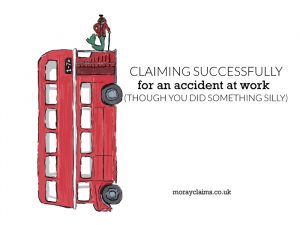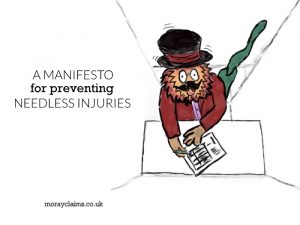Have you ever panicked that you have mislaid your mobile phone? And that while you are in the middle of a conversation with someone on your mobile phone? This happens to me regularly. So many things compete for our attention and so much of the activity that fills our day is done almost unconsciously, on autopilot. The repetitiveness of everyday life dulls our concentration and our short-term memories. Sometimes distractions can be a source of danger, whether that’s while you’re descending the stairs in your house or crossing the street or working on a production line. In this article we are going to concentrate on accidents at work. We will look at 3 different accident scenarios where you might think the injured employee 'should have known better' yet still claimed successfully. Firstly, we’ll look at the case of the exposed window cleaner. Then, we’ll go on to consider the case of the labourer with inappropriate footwear. Finally, we’ll go over the case of the bus Continue Reading
Prevention of needless injuries (the APIL manifesto)
How many accidents are there in the UK each year which cause injury to people? One estimate is 1.6 million – totalling up harmful incidents across workplaces, hospitals and on the roads. (There were 560,000 casualties on the roads in 2018). All of these are preventable injuries. Yet they can have permanent, life-changing consequences not just for the injury victims but also for their families. On the other side of the picture, the wrongdoer who caused the injuries – an employer, the NHS, a business, a local authority – can suffer damage to reputation as well as financial cost. Every year, the Association of Personal Injury Lawyers (APIL) hosts Injury Prevention Day. It encourages us all to think about ways we can adjust our conduct to minimise the risk of harm to others (e.g. avoiding tailgating the vehicle in front if we are driving). Everyone has a part to play in reducing accidental injuries but, for maximum effectiveness, the lead has to come from government. It is our Continue Reading
Knowing whether Legal Expenses Insurance covers you for a personal injury claim
We thought it might be helpful to analyse a clause from a legal expenses insurance (LEI) policy relating to cover for making a personal injury claim. It’s just one type of clause out of many in a LEI policy but it is a foundational one relative to personal injury claims. What is LEI? LEI is one way to insure yourself against the risk that a personal injury compensation claim you make might fail in such a way that you could be responsible for the costs (legal expenses) of your opponent. Typically, that can only happen if you get to the stage where you have to raise a court action to pursue your claim – so legal expenses insurance is insuring you against the risk of losing your claim in court. While it is possible to buy LEI as a standalone policy, most LEI policies are added to home or car insurance as an optional extra. LEI policies bought ‘before the event’ (BTE) protect policyholders in case legal action has to be brought or defended in the future. This type of policy would be Continue Reading
How to avoid throwing money away on your personal injury claim
Scottish solicitors’ firms have to do formal risk management training every year. This is particularly to minimise the risk of making mistakes which might mean we end up getting sued because of losses we might cause to our clients. We had a recent session in our Elgin office where the “system” to assess risks in our work on a daily basis was summarised as: Stop and think Do as you have been told (i.e. we have a lot of systems and procedures already for managing risk) Repeat one and two Everything looks clear with hindsight. You want to avoid looking back on things with regret, if possible. It can be especially annoying if, due to not “stopping and thinking”, you make a silly error which results in a loss to you personally or to your workplace. It’s a bit like that with personal injury claims and, from our perspective, there is an avoidable mistake many injured people make at the start of their personal injury claim. It causes financial loss to them. It’s not obvious, though, Continue Reading



